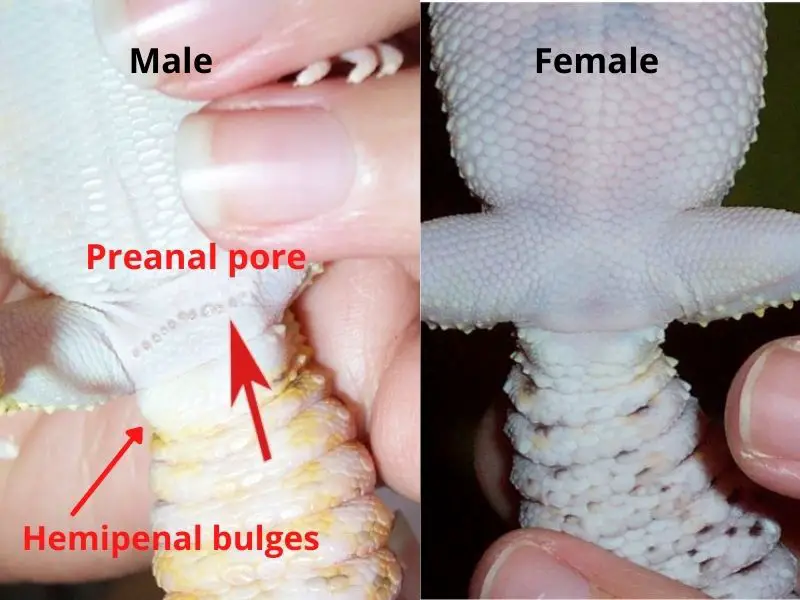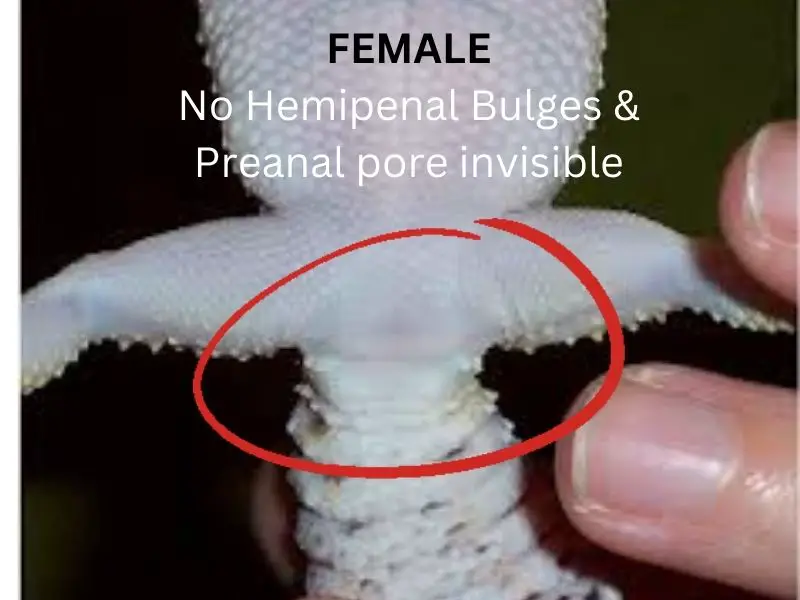It might be hard to tell the gender of a leopard gecko at a glance or when the gecko is running around in the vivarium. The reptiles have characteristic features underneath them that enable a breeder to differentiate between male and female geckos. Here are some ways to tell if a leopard gecko is male or female.
How to tell the sex (gender) of a leopard gecko

The gender of a leopard gecko can be known by looking at some features on the underside of the reptile. Picking up the gecko is the best way to make observations; roughly handling the reptile may result in a bite.
Hold the gecko with slight pressure to keep him from slipping out of your hand, which is opposed to snatching him up. When you grab their tail, the leopard gecko will drop the tail as a defense mechanism leavening him exposed to infections before he grows another one.
The other way to tell the sex of the gecko is to put him inside a transparent glass tank and observe from beneath. This will relieve the reptile from the stress of direct contact and moving him around or falling from your grip.
Below are some of the characteristics to look out for:
1. Preanal Pores

Both female and male geckos have pores known as preanal pores. The naked eye cannot see the female pores, while the male pores are easily visible. The leopard gecko excretes waxy substances with pheromones through these pores.
The reptile then rubs the substance on the surfaces of the rocks and his tank to let other geckos that this is his territory. The pheromones also help the gecko to court when they are at their active sexual level. If your leopard gecko is male, you should be able to see small doted pores in a V-formation.
2. Hemipenal Bulges

The male sexual organs of leopard geckos are known as hemipenes. When the gecko is sexually mature, the hemipenes develop as two bulges beneath the leopard gecko’s vent at the horizontal slit in the base of his tail. The bulges hide the hemipenes until the male leopard gecko is ready to mate with a female. Hemipenal bulges are not too big but are noticeable to the human eye. This way, you can tell whether you have a male or a female gecko, as the females do not develop bulges.
3. Femoral pores
- Some male leopard gecko species with femoral pores similar to the preanal pores. The only difference is that they are on the back legs and form a straight line. They are at the lower part of your gecko’s tail and have a small, thorn-like structure. The pores in males are used to secrete pheromones. However, both males and females may have them.
- The difference is in male leopard geckos. The pores are too distinctly visible. In female geckos, if present, the pores are very small and barely noticeable.
READ ALSO: 12 Great Female Leopard Gecko Names [With Meanings]
Male vs Female Leopard Geckos Differences
Male and female leopard geckos have distinctive characteristics that differentiate them. The two genders are different in size, behavior, and lifespan. Here are some noticeable differences in both male and female geckos.
Chirp Noises from the gecko
Male geckos are territorial reptiles who make chirp sounds to warn other approaching geckos of their territory.
The male chirps get louder as the gecko feels more threatened by other geckos. Chirp noises are also meant to call female geckos for mating, and the male chirps to announce their presence during the breeding season. Female geckos make chirp noises when hungry and need to be fed.
Read More: What Noises Do Geckos Make? Gecko Noises and Meanings
Temperament
Male leopard geckos show more aggression towards prey and they launch for their food during feeding time. The male reptile feeds more than the female and does not shy away from eating. In contrast to the female gecko, they are less frightened of humans approaching their vivarium and exhibit more curiosity.
Leopard geckos are also best put in separate tanks. The male reptiles are territorial, and fights will occur if the tank has more than one male. Leopard Gecko fights are deadly, resulting in bites and exposed wounds that lead to infections.
On the other hand, female geckos try to intimidate their prey by shaking or waving their tail. Instead of launching after prey like the male leopard geckos, females will take time to eat and enjoy their food. The female reptiles get full after feeding and will refuse the last worm.
When a female gecko is ovulating, the eating decreases or stops completely, and during this time, the gecko will depend on the fats stored in its tail. The female gecko is shy from human contact and likes hiding away under rocks, and prefers to be left alone unless it is feeding time.
Lifespan
Male geckos live longer than female geckos with proper care and fewer health issues. The male geckos have a more consistent eating pattern and rarely skip meals unless they are ill.
Female geckos have a shorter lifespan than male geckos. Breeding the female gecko too much will shorten its lifespan.
| Male leopard geckos | Female leopard geckos |
| They have two mounds at the base of their tail | Female geckos do not have mounds at the base of their tail |
| Male geckos have more visible preanal pores that are V-shaped | Female geckos have less visible preanal pores, the pores are virtually invisible |
| Male geckos have more visible femoral pores at the back of their thigh | Female geckos have less visible femoral pores |
| Male leopard geckos are large and have broader heads and necks | Female leopard geckos are smaller in size with a narrower frame, head and neck |
Can you tell the gender of a baby leopard gecko?
There isn’t much difference between male and female baby geckos; therefore, it is almost impossible to tell the gender of a juvenile leopard gecko. The sexual organs are not yet developed and only become visible when the gecko is around ten months old. At ten months, the baby gecko becomes a young adult exposing bulges or pores that determine gender.
To tell if a leopard gecko is a boy or girl, you can consult the breeder from whom you got your pet. However, you might still have to wait till the baby gecko is older to be sure.
Is it better to have a male or female gecko?
Male leopard geckos live longer with proper care, feeding and fewer health-related issues. The male geckos have better physical looks compared to the female gecko. Wider heads with large bodies give male leopard geckos a better physique making pet owners pick them out more.
The female geckos get smaller during ovulation; they stop eating and lose appetite, giving the reptile breeder a stressful time. The female gecko loses weight during this period and can easily fall sick, putting them at higher risk of diseases.
Male leopard geckos have a more consistent feeding pattern. In good environmental conditions, they rarely fall sick, making them easier and better to have than female leopard geckos.
Can a male and female leopard gecko live together?
Female leopard geckos cannot live in the same tank as male leopard geckos. The species are very territorial and will fight off any threat. It is recommended to keep them in separate tanks to avoid fights and injuring one another. Fights often lead to stress or injuries, making the geckos lay off food. This results in geckos losing weight and possible infections caused by the exposed injuries.
The females are also best separated from baby leopard geckos to avoid attacks and injuries on the baby reptiles. It is best to have each gecko in its vivarium and put them together only during the breeding season. Male and female geckos do not coexist well in the same tank.
READ NEXT: 13 Unique Boy Gecko Names for Your Pet

